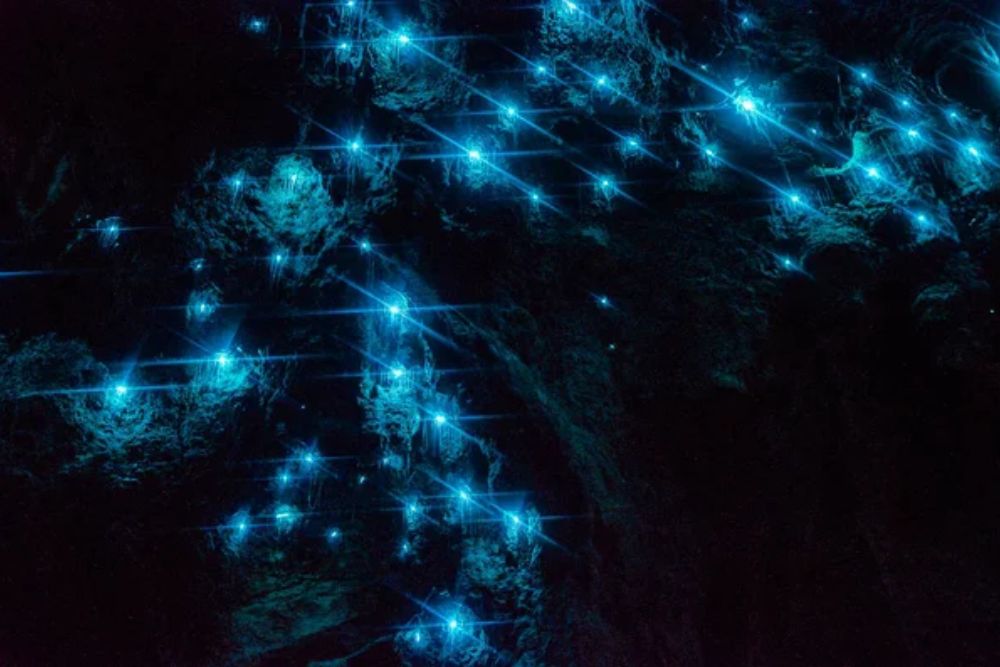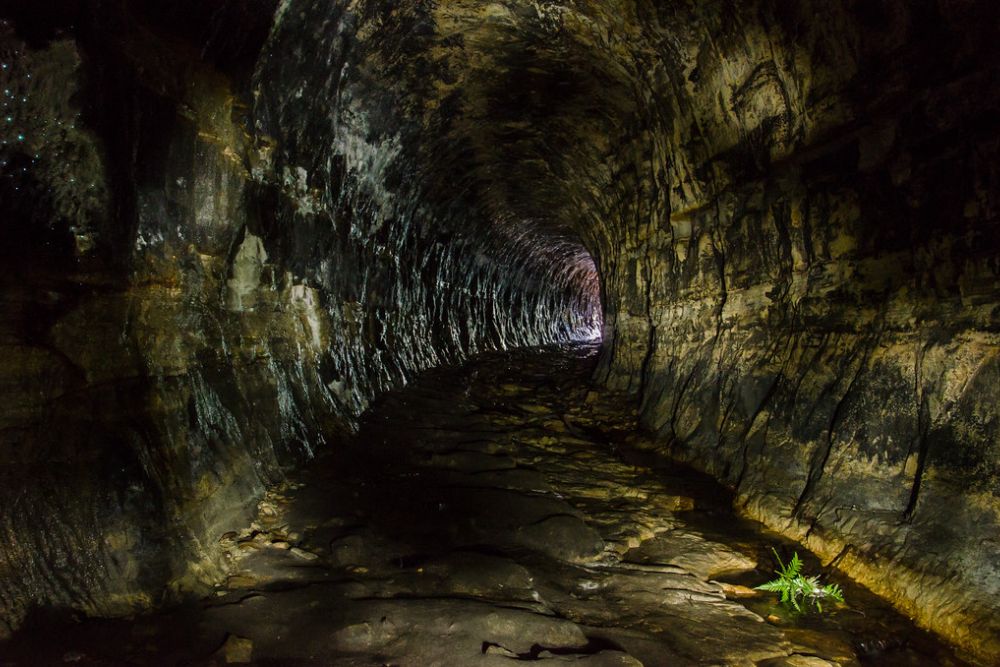New Zealand is home to some of the world’s most magical underground spectacles. These bioluminescent creatures, called Arachnocampa luminosa, are exclusive to New Zealand, create natural light shows that rival any city skyline. From the famous tourist caves with guided tours to hidden gems you can explore on your own, the country offers cave experiences for every type of adventurer.
Finding glowworms feels like discovering a secret world where biology meets magic. Here is a list of 20 New Zealand glowworm caves you can visit to witness this extraordinary natural phenomen
Waitomo Glowworm Caves

The most famous glowworm cave in New Zealand has been attracting visitors for over 130 years. You’ll walk through stunning limestone formations before taking a silent boat ride through the Glowworm Grotto, where thousands of tiny lights create an underground starscape.
The cave stays at a constant cool temperature year-round, so bring a jacket even on hot summer days.
Te Anau Glowworm Caves

Your adventure begins with a scenic cruise across Lake Te Anau before entering these geologically young caves that are only 12,000 years old. Underground streams and waterfalls add to the drama as you drift silently beneath thousands of glowworms in a hidden grotto.
The boat ride across the lake makes this feel like a proper expedition into uncharted territory.
Like Travel Pug’s content? Follow us on MSN.
Spellbound Cave

Often considered the most magical glowworm experience on earth, Spellbound Cave near Waitomo offers an intimate encounter with these luminous creatures. The smaller group sizes mean you get a more personal experience than the larger commercial caves.
The cave formations are particularly stunning, with delicate limestone features that have taken millions of years to form.
Waipu Caves

These publicly accessible caves in Northland offer one of the best glowworm displays you can see without paying admission. You’ll find thousands of glowworms scattered throughout three chambers, creating what looks like a glowworm galaxy overhead.
Just be prepared to get your feet wet as you navigate the underground streams.
Ruakuri Cave

This wheelchair-accessible cave features a spectacular artificial spiral entrance that opens onto extensive limestone formations and crystal tapestries. The cave is the largest in the Waitomo area and offers an up-close look at glowworms without the boat ride.
It’s the only cave in the Southern Hemisphere that’s fully wheelchair accessible, making it perfect for families with mobility needs.
Like Travel Pug’s content? Follow us on MSN.
Abbey Caves

Located near Whangarei, these three interconnected limestone caves offer a more adventurous glowworm experience. You’ll need to bring your headlamp and be prepared for some scrambling over rocks.
The reward is seeing glowworms in their natural state without crowds or tour groups interrupting the silence.
Charleston Glowworm Cave

Located on the West Coast’s remote wilderness, you’ll explore the Te Ananui caves just as the first cavers did: with only a torch and helmet. The journey includes a scenic ride aboard the Rainforest Train through the Nile River Canyon before reaching this off-the-beaten-track destination.
The adventure feels authentic and wild compared to more commercialized cave experiences.
Aranui Cave

Although this Waitomo cave doesn’t have glowworms due to the absence of water, it compensates with some of the most spectacular pale brown, pink, and white stalactites and stalagmites in the region. Many visitors combine this with other nearby glowworm caves for a complete underground adventure.
The formations here are so pristine that they look almost artificial.
Like Travel Pug’s content? Follow us on MSN.
Hokitika Glowworm Dell

This cozy dell at Hokitika’s northern entrance is free to enter and can be explored without a guide. After a short bushwalk, you’ll find yourself surrounded by glowworm colonies that illuminate the cave’s darkness.
The best time to visit is during dusk or after dark when the glowworms are most active.
Kawiti Glowworm Caves

Located in the heart of the Waiomio Valley in Northland, these caves are home to thousands of luminous glowworms amid breathtaking rock formations and lush rainforest. The guided tours here include both day and twilight options, with local experts sharing fascinating details about the glowworm ecosystem.
The surrounding valley setting makes this feel like a complete nature experience.
Cascade Falls

Near Rotorua, this location combines the beauty of a waterfall with glowworm viewing opportunities. The damp environment around the falls creates perfect conditions for glowworms to thrive.
You can often spot them clinging to the moss-covered rocks and overhanging vegetation after dark.
Like Travel Pug’s content? Follow us on MSN.
Blue Lake

This Rotorua location offers glowworm viewing in a stunning natural setting. The geothermal activity in the area creates unique microclimates that glowworms love.
Visitors often combine glowworm spotting here with other Rotorua attractions like hot springs and mud pools.
Mangapohue Natural Bridge

This Waitomo area attraction combines dramatic limestone formations with glowworm colonies. The natural bridge itself is an impressive geological feature, and the surrounding caves and overhangs provide habitat for glowworms.
It’s a great spot for those who want to see glowworms without going deep underground.
Coromandel Glow Worm Tunnel

The Coromandel Peninsula offers family-friendly glowworm viewing, with bushes along tracks starting to twinkle after dark. The easy access makes this one of the most family-friendly places to see glowworms in New Zealand.
You can combine this with a visit to the famous Hot Water Beach for a perfect Peninsula adventure.
Like Travel Pug’s content? Follow us on MSN.
Clifden Caves

These limestone caves in Southland take 1-2 hours to navigate and offer an adventurous route where you might get your feet wet walking alongside pools. The cave network is prone to flash flooding, so avoid visiting during or after heavy rainfall.
The remote Southland location means you’ll likely have the caves mostly to yourself.
Okupata Caves

Hidden in Tongariro, these unmarked caves offer an underground adventure with glowworms and fun navigation challenges. The gravel road to reach them is full of potholes, so make sure your vehicle can handle the journey.
The unmarked nature means you’ll need to remember your route to find your way back out.
Kakahi Glowworms

Just outside the North Island settlement of Kakahi, this 100-meter-long grotto exists thanks to a railway cutting through the Whakapapa River that was never used. Instead of trains, the tunnel now hosts a thriving glowworm colony.
The straight-line nature of the old railway cutting makes navigation simple even for inexperienced cavers.
Like Travel Pug’s content? Follow us on MSN.
Pukekura Park

Located in New Plymouth, this urban park offers glowworm viewing without leaving civilization. The glowworms live on overhanging banks along the Pukatea Stream, visible from paths in the Main Garden area.
It’s perfect for those who want to see glowworms but prefer to stay close to amenities and easy parking.
Nicols Creek

This Dunedin area location provides glowworm viewing opportunities on the South Island. The creek environment creates the damp conditions that glowworms need to thrive.
Local knowledge helps here, as the best viewing spots aren’t always obvious to first-time visitors.
Trotters Gorge

Located near Moeraki on the South Island, this gorge offers glowworm viewing in a dramatic natural setting. The limestone formations and native bush create a perfect glowworm habitat.
The coastal location means you can combine glowworm viewing with other South Island coastal attractions.
Like Travel Pug’s content? Follow us on MSN.
Nature’s Underground Cities

These remarkable creatures aren’t worms at all, but the larvae of fungus gnats that emit blue-green light through a chemical reaction between an enzyme and oxygen. This bioluminescent process is incredibly energy-efficient, converting 90% of energy into light compared to just 20% for modern LED bulbs.
Today’s glowworm caves continue the legacy that began when Maori chief Tane Tinorau first explored Waitomo’s underground waterways in 1887, proving that some natural wonders never lose their ability to inspire awe. The caves represent living laboratories where millions of years of geological processes meet the delicate balance of modern ecosystems, creating spaces where visitors can witness evolution and time itself carved into stone.
More from Travel Pug

- 20 Best Beach Towns in the Carolinas
- 13 Destinations Where Tourists Regularly Regret Their Trip
- 20 Destinations That Are More Magical Without an Itinerary
- 20 Underrated Adventures That Belong on Your Travel List
- 20 Cities Where You Should Just Wing It, No Planning Required
Like Travel Pug’s content? Follow us on MSN.N.
